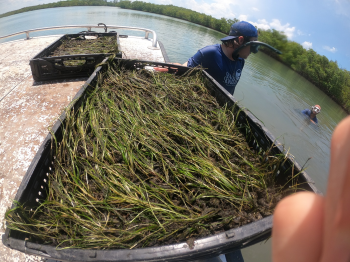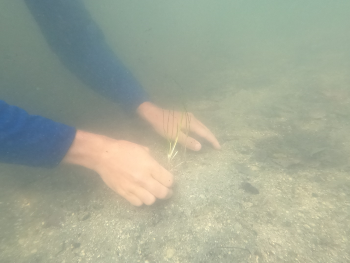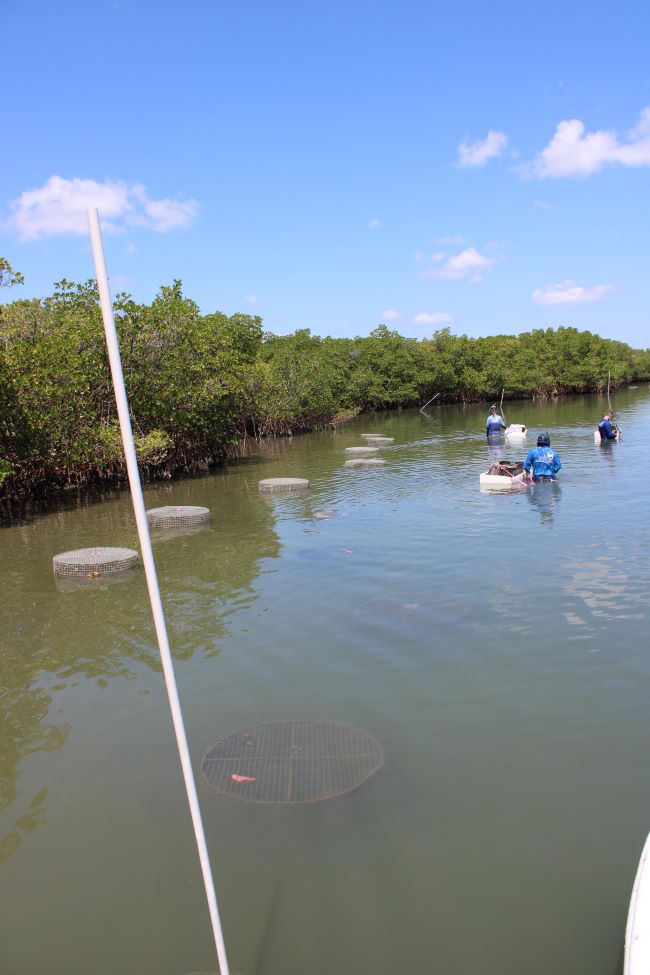 20 acres of seagrass are in the ground.
20 acres of seagrass are in the ground.
And we’re just getting started. Just inside the St. Lucie Inlet on the north side of the main waterway is a small, inconspicuous natural area known as Tucker Cove. The waters in and adjacent to This little gem used to be productive fishing grounds, with seatrout often taking center stage. For a variety of reasons, seagrasses throughout much of the Indian River Lagoon region have gone through a major die-off, having the exact impact you’d think it would on the fishery (among many other things) – the fishing for the past 5 years or so simply stinks.
Three months ago (July 2023), a team of biologists from Sea & Shoreline, LLC, planted 20 acres of shoreline with seagrass, following a method that has proven successful in a variety of locations around the state.
The Angler Action Foundation funded the project with legislative funds from Florida’s Department of Environmental Protection (DEP).
 In 2020, The IRL Council funded a two-acre project in the area to see how the seagrass would take. The results, combined with the successes achieved in similar projects (including the Caloosahatchee River, where restoration is currently underway) were enough for AAF to move forward with the larger scale projects.
In 2020, The IRL Council funded a two-acre project in the area to see how the seagrass would take. The results, combined with the successes achieved in similar projects (including the Caloosahatchee River, where restoration is currently underway) were enough for AAF to move forward with the larger scale projects.
Biologist Jessica “Jess” Mailliez, Sea & Shoreline’s Senior Environmental Manager, led the planting process.
The procedure starts at the seagrass farm in Ruskin, FL, where local varieties of seagrasses are grown out and prepared to be planted at locations which are very carefully selected, which helps ensure overall success. In this case, the bulk of the grass is Shoal Grass (halodule wrightii), with a smaller percentage of Widgeon Grass (rupia maritima). Each was selected for different reasons, but the important thing to understand is that they can work together to provide ground cover, and having two species with slightly different tolerances hedges our bet, so to speak.
AAF employed a similar technique in the Caloosahatchee River, where an extensive seagrass restoration project is underway – but rupia’s partner in that project is freshwater eel grass.
Jess explained the major differences when it comes to planting Shoal Grass as opposed to freshwater grass. “Of course, the big difference is that Shoal Grass is a saltwater species, but what makes it different from a process standpoint is that it is a bit more fragile than tape grass, so it takes about twice as long to install."
Sea & Shoreline brought more plants than were actually contracted for, so they were able to do a lot of bare root planting, which is also more time consuming but increases the odds of success. They also canvass the area with a ‘man powered’ contraption which inserts smaller, single plant units throughout the entire 20 acres. There are also larger, more mature plants in peat pots which are hand planted, then protected with Sea & Shoreline’s Herbivory Exclusion Devices – essentially these are strong, small mesh metal cages that protect the precious peat pots from being eaten by a host of hungry critters such as manatees, ducks, certain fish and more. The need for the cages was demonstrated during the original pilot study in Tucker Cove, as grazing was an issue.
 Three months in, how is it going? Jess has the scoop: “The project has had a mostly successful start. Of course, there are always unforeseen challenges and we’re dealing with that a bit here in that the visibility in the water has been extremely poor since we started. Which is odd, because that wasn’t the case just before – but thankfully we planted only in the shallow rim of the area so sunlight shouldn’t be an issue in the long run. And we expect the clarity will improve to normal soon. At that time we will know for sure the status of the plants in the ground.”
Three months in, how is it going? Jess has the scoop: “The project has had a mostly successful start. Of course, there are always unforeseen challenges and we’re dealing with that a bit here in that the visibility in the water has been extremely poor since we started. Which is odd, because that wasn’t the case just before – but thankfully we planted only in the shallow rim of the area so sunlight shouldn’t be an issue in the long run. And we expect the clarity will improve to normal soon. At that time we will know for sure the status of the plants in the ground.”
The shallower banks were selected as the initial 20 acres for planting for just this possible scenario, but it was still a surprise. Being so close to the inlet, I personally expected excellent water clarity. But the outgoing water has been cleaner than the incoming water lately. Thankfully, it shouldn’t have too much of an impact on the long-term success.
As we ease in to winter, seagrass growth slows all over the state. “Roots will continue to grow, but leaves will grow much less on a week to week basis as water cools and the number of daylight hours decreases. But even if it sheds above ground biomass, seagrass roots will continue to grow and we’ll see clonal plants start popping up in the spring,” Jess assured me. “Water clarity generally improves during the cooler months too, so the loss of daylight hours per day is balanced by cleaner water.”
 The benefits of seagrass are many. Anglers are well aware of the relationship between healthy seagrass beds and productive fishing. It also traps sediment (further improving water clarity), pulls nutrients such as nitrogen and phosphorus from the water column, and sequesters carbon. But for us angling types, the improved habitat is the ultimate win. Seagrass is so inviting, the installation crew found an octopus stowing away in the grass before it was even removed from the trays.
The benefits of seagrass are many. Anglers are well aware of the relationship between healthy seagrass beds and productive fishing. It also traps sediment (further improving water clarity), pulls nutrients such as nitrogen and phosphorus from the water column, and sequesters carbon. But for us angling types, the improved habitat is the ultimate win. Seagrass is so inviting, the installation crew found an octopus stowing away in the grass before it was even removed from the trays.
Sea & Shoreline will continue monthly monitoring of the project for a period of three years. That includes manually scrubbing the protective cages so light is not blocked (seagrass is just like terrestrial grass in that it needs sunlight to survive), observing the health of the project, and determining whether supplemental planting is needed.
This 20-acre project is “phase 1” of a larger scope. The IRL system is rife with algae of different varieties right now, and has been since the seagrass die-off. The plan is to bring seagrass back as the dominant green biomass in the lagoon. Planted grass will thrive and spread, so we won’t need to plant the entire lagoon or river. But finding strategic locations which have the best survivability odds and located in areas where currents can assist the expansion.
If you are in the area, please do idle nearby and check out the project. Obviously, we hope you’ll respect the boundaries marked with buoys because as Jess noted, this grass is delicate. Especially at this stage of the project.
Here’s to better habitats, water quality, and fishing throughout the State of Florida.
Questions? Email Brett@angleractionfoundation.org

